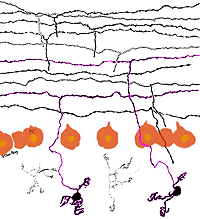Cerebellar Cortex:
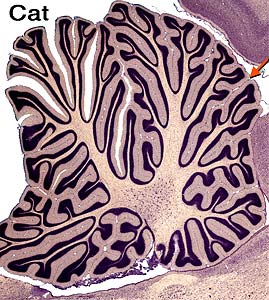
The cerebellar cortex, which covers the surface of the cerebellum, is composed of three layers:
- The superficial molecular layer is relatively acellular. It is packed with axons of granule cells (parallel fibers) synapsing on dendrites of Purkinje neurons.
- Cell bodies of Purkinje cells distributed along the deep surface of the molecular layer constitute the middle Purkinje cell layer.
- The deep granule cell layer features densely packed nuclei of very small neurons.
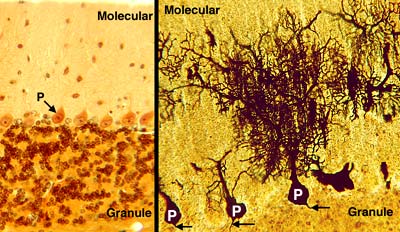
Neurons of Cerebellar Cortex:
- Purkinje cells (neurons) are the largest neurons in the brain. They have extensive dendritic trees that are broad perpendicular and compressed parallel to the length of the folium. The dendrites fill the molecular layer. The axons run through the white matter and synapse in cerebellar nuclei (or in vestibular nuclei). Purkinje axons engage in inhibitory synapses; they release GABA as a neurotransmitter.
- Granule cells (neurons) are the smallest neurons in the brain. They are the only excitatory neurons in the cerebellar cortex; they release glutamate as a neurotransmitter. Axons of granule cells enter the molecular layer, bifurcate, and run along the length of a folium (parallel fibers). Each granule cell makes synaptic contact with numerous Purkinje neurons along a longitudinal band.
- Basket cells (neurons) are located in the depth of the molecular layer. Their dendrites receive excitatory synaptic input from parallel fibers. Their axons run transversely in the folium and inhibit bands of Purkinje cells that border the excited zone. Axonal branches form basket synaptic contacts around initial segments of Purkinje axons and release GABA.
- Golgi cells in the granule cell layer and stellate cells in the molecular layer serve as inhibitory interneurons.
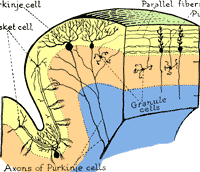
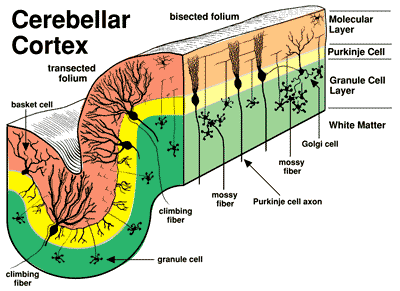
Cortical Afferent Fibers:
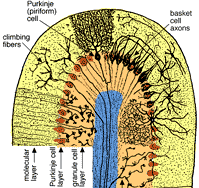 Two types of afferent fibers enter the cerebellar cortex. Both afferent types are excitatory to the cortex and they send excitatory collateral branches to cerebellar nuclei before entering the cortext. The afferent fibers are:
Two types of afferent fibers enter the cerebellar cortex. Both afferent types are excitatory to the cortex and they send excitatory collateral branches to cerebellar nuclei before entering the cortext. The afferent fibers are:- Mossy fibers — have terminations that resemble moss. The moss endings synapse in glomeruli, with dendrites of granule cells. Mossy afferents come from all sources (spinal cord, pontine nuclei, vestibular nuclei & nerve) except the reticular formation.
- Climbing fibers — terminate by climbing the dendritic tree of a Purkinje neuron, exciting it greatly via numerous synaptic contacts. All climbing fibers come from the olivary nucleus. Like mossy fibers, climbing fibers send excitatory collaterals to cerebellar nuclei before terminating in the cortex.
Cortical Circuitry:
- Afferent fibers, both climbing and mossy, are excitatory. The fibers send collaterals to cerebellar nuclei before terminating in cerebellar cortex.
- Climbing fibers excite Purkinje cells directly. Mossy fibers excite granule cells. Granule cells excite bands of Purkinje cells and basket cells along the length of a folium. Basket cells inhibit Purkinje cells along the bilateral margins of the excited band.
- Purkinje cell axons terminate in cerebellar nuclei (or vestibular nuclei) where they selectively inhibit output neurons. Efferent axons from cerebellar nuclei constitute cerebellar output.
- Note: Granule cells are the only excitatory cells in the cerebellar cortex, all other cells are inhibitory. Purkinje cell axons are the only axons that leave the cerebellar cortex.
